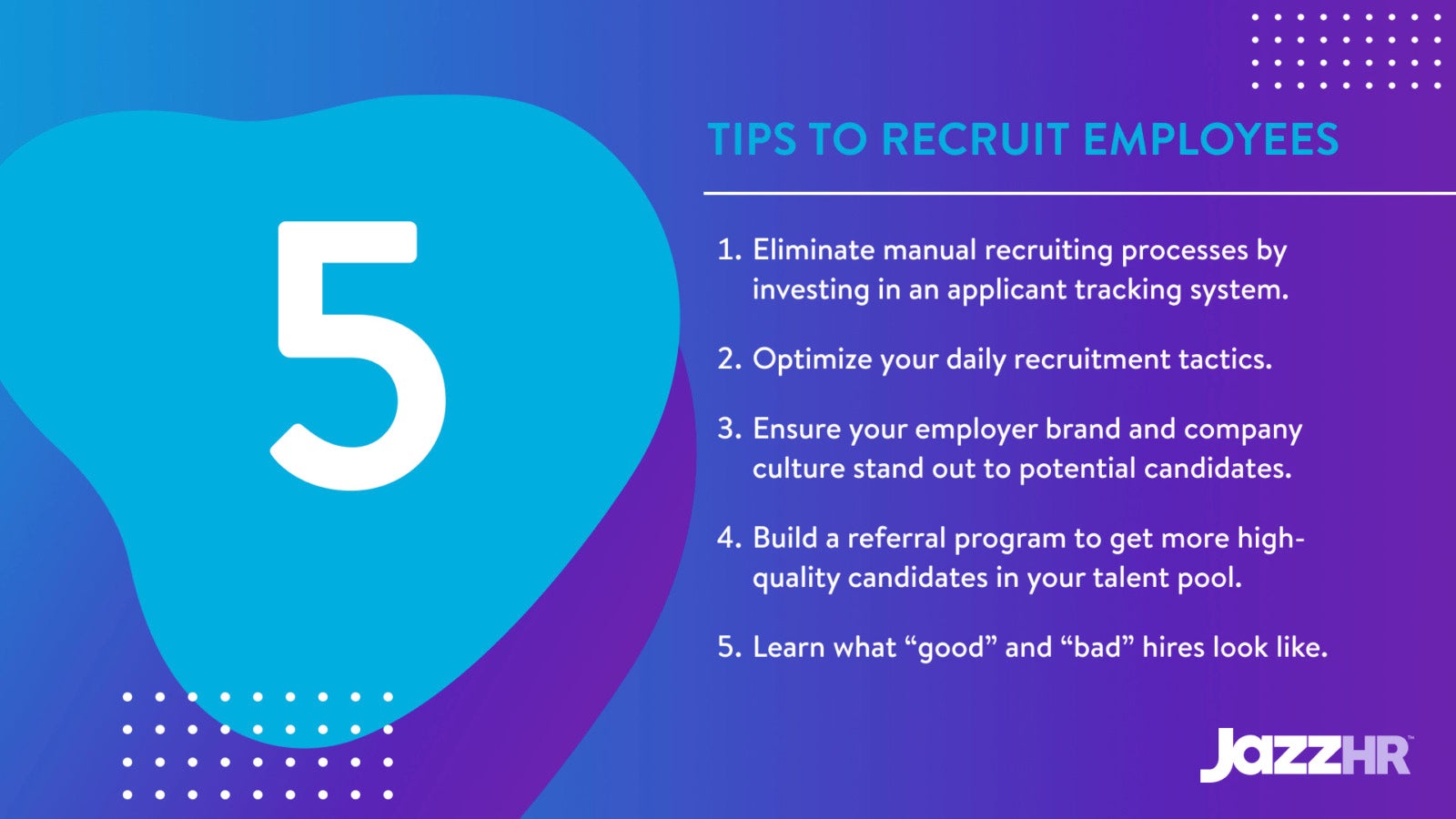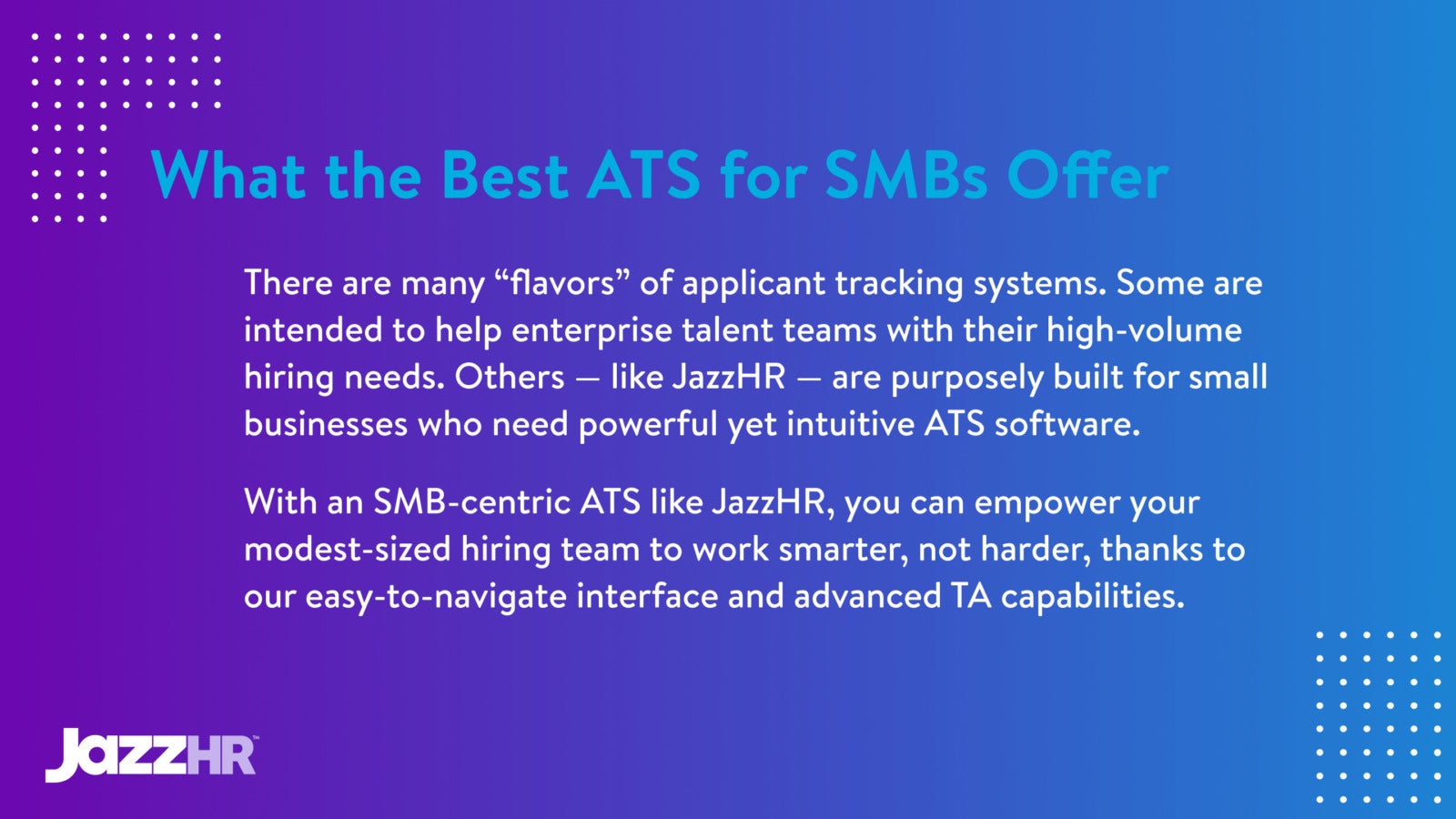Knowing how to recruit employees to join your small or scaling business is both an art and a science.
On the art side, experience leads to knowledge. But, the science component — using data-driven recruiting technology that provides analytical insights into each individual hiring cycle and candidate engaged — is equally important to your long-term talent acquisition success.
How to recruit employees: 5 tips for your small business
Looking to learn how to recruit employees in a more scalable and repeatable way? You’ve come to the right place. Here are five expert SMB recruiting tips to help your human resources team.
Specifically, ones that can lead to more efficient interview processes, smarter candidate sourcing and nurturing efforts, and higher hiring conversion rates for your small business in the long term.
1) Eliminate manual recruiting processes — and invest in an ATS
Some small businesses continue with manual recruitment processes because they can’t see just how inefficient their current approach (likely one that utilizes spreadsheets) truly is. Others think moving to an actual hiring software solution would be too costly or take too much time to learn.
Regardless of which reason you have for sticking with the status quo, as it relates to carrying out your recruiting activities, just know there’s a better way to execute your strategy.
- More to the point, there are built-for-purpose, easy-to-use solutions that can automate key recruitment tasks and save you time — time you can use to tackle other critical hiring-related responsibilities and HR duties.
Consider Comfort Dental. The business recognized it could streamline many daily recruiting tasks with an applicant tracking system (ATS) — specifically, JazzHR. Now, the company can now use our SMB hiring platform publish and syndicate postings to multiple job boards with a single click.
(That is to say, as opposed to having to manually promote new job openings to each individual online career community and social media site — a formerly painstaking and time-consuming task.)
“I like that JazzHR sends our job posting everywhere, so that I don’t have to have five different accounts to post to various job boards,” the Comfort Dental team noted. “I just post once within JazzHR and I am done.”
2) Optimize (and test new tactics with) your recruitment strategy
Onboarding a small business applicant tracking system is essential for your long-term hiring success.
But, remember: A purpose-built ATS for SMBs like JazzHR is much more than simply a place where you can store data tied to job seekers. It’s also your single source of truth where your HR team and hiring managers can work from to enhance every element of your recruitment strategy.
Just look at how HR teams with JazzHR make the most of our powerful ATS system:
- Customizing job applications and their careers site: Ensure your job postings feature questions of relevance to your small business and the role/team in question to ensure you can qualify and disqualify potential candidates with greater ease. For instance, many JazzHR customers use knockout questions to automatically disqualify poor-fit job seekers.
- Testing different candidate engagement messaging: Not every candidate prefers the same kind of communication from recruiters. Some like getting InMail messages on LinkedIn. Others don’t mind receiving cold emails and/or texts from HR teams. So, be sure to see which types of communications mediums
- Analyze their workflows, sourcing, and hiring speed: Using Advanced Visual Reporting, JazzHR customers can easily see how efficient their hiring workflows are, which sourcing channels generate high-quality candidates, and their average time to hire (i.e., how quickly recruiters and hiring managers have offers accepted by engaged job candidates).
The list goes on. The point is, with leading recruiting software for small businesses at the center of your HR tech stack, you can consistently strengthen your entire hiring process: from the moment you initially engage top talent regarding open positions, to when you send a formal offer.
3) Ensure your employer brand and company culture stand out
Consider this item a prerequisite to recruiting success (and use of an ATS) — but one that can’t be ignored.
Let’s start with your employer branding. How your small business is perceived externally doesn’t just impact sales. It also affects the number of qualified candidates who consider applying.
Many active job seekers certainly get sucked into postings due to an attractive job title.
- But, many of them also do additional research (e.g., checking Glassdoor reviews) beyond the application to ensure any prospective employer they consider joining is one their existing employees like working for.
So, do a bit of research to see how your employer brand is regarded internally (i.e., by sending in-house employee Net Promoter Score (eNPS) surveys to current employees) and the general public (i.e., learning what customers and previously engaged candidates say about you online).
As for your company culture, well, that’s an initiative that isn’t solely owned by your HR team. Your people managers and executives also play a pivotal role in building a strong, attractive culture.
The decision tree here is fairly simple:
- If your eNPS survey results show your employees are mostly (if not entirely) thrilled with your company culture (i.e., feel like they contribute to business growth, are rewarded for their hard work, and are satisfied with their current jobs), that means you have lots of brand evangelists who can help spread word about how great your SMB is and even promote open roles on social media.
- If your eNPS survey results show your workforce isn’t all that happy with or excited about your culture, new employee engagement approaches and internal mobility and training programs likely need to be implemented to address workers’ concerns around work-life balance, promotion opportunities, and the like.
In the latter case, only when culture improvements are instituted can you even think about approach any employees to aid with your recruiting efforts (e.g., take part in a brand testimonial video to share how much they like working at the company).
4) Build an employee referral program to bolster your sourcing
“Finding talent is tough, and recruiters need to arm themselves with tools to find quality candidates for open roles,” Employ SVP People & Talent Corey Berkey recently wrote for Undercover Recruiter.
Yes, Corey’s referring to an ATS, but not just for the obvious reasons. Rather, he’s also referring to an advanced yet intuitive recruiting platform for SMBs like JazzHR that enables HR teams to secure referrals from existing employees — and, in turn, alleviate the sourcing stress on recruiters.
- Developing an employee referral program isn’t as daunting a task as it sounds. Well, with the right applicant tracking system in place, that is.
JazzHR gives HR generalists and hiring managers the ability to modify the referral email template in our ATS to ask existing members of their staff to share referred candidates with them using JazzHR.
Those who do get a bespoke referral link that makes it easy for recruiters to know where a referred job seeker came from (and, thus, can ensure they get paid for the referral, should they get hired.
The added bonus of generating a high volume of referred leads? Your recruiters don’t have to spend nearly as much time sourcing. Instead, they can address other pressing needs and action items.
5) Understand what “good” and “bad” hires look like using data
This is a pretty short-and-sweet tip on how to recruit employees for your small business. Use the data in your ATS of choice (ideally, one with out-of-the-box analytics) to track quality-of-hire metrics.
For example, JazzHR customers can “drill down” into their sourcing data in AVR to learn which channels led to the most candidates moving far into their hiring process (those who are hired and make it to the final selection phase) and those who “exit” their process in the early stages.
Commonalities tied to both of these types of (e.g., certain types of skills and other qualifications, the job board or career community where they were sourced) can inform where your recruiters should spend their time sourcing and posting job openings — and where they should stop doing so.
Learn how to recruit and hire employees more efficiently and effectively with our easy-to-use applicant tracking system built specifically for small businesses like yours. Schedule a demo today.








